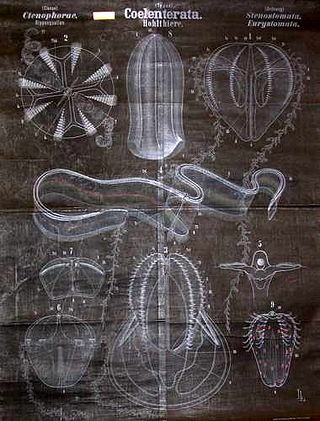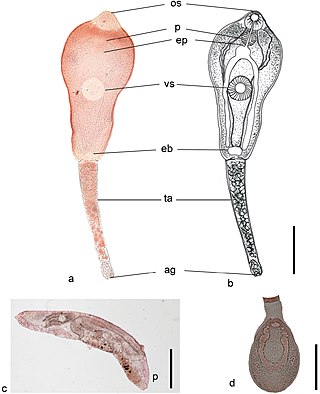
Digenea is a class of trematodes in the Platyhelminthes phylum, consisting of parasitic flatworms with a syncytial tegument and, usually, two suckers, one ventral and one oral. Adults commonly live within the digestive tract, but occur throughout the organ systems of all classes of vertebrates. Once thought to be related to the Monogenea, it is now recognised that they are closest to the Aspidogastrea and that the Monogenea are more closely allied with the Cestoda. Around 6,000 species have been described to date.

Strongyles, or alternatively, strongyls, are nematode worms of the family Strongylidae, order Strongylida. They are often parasitic in the gastrointestinal tract of mammals, especially grazers such as sheep, cattle, and horses.

Arthur Looss was a German zoologist and parasitologist. Looss was born in 1861 in Chemnitz, and was educated both there and in Łódź, Poland. Thereafter, he studied at the University of Leipzig, where he received a doctorate for his study of trematodes.

Plagiorchiida is a large order of trematodes, synonymous to Echinostomida. They belong to the Digenea, a large subclass of flukes. This order contains relatively few significant parasites of humans.

Echinostomata is a suborder of the parasitic flatworm order Plagiorchiida. The suborder contains numerous species that are parasitic in humans.

Opisthorchiidae is a family of digenean trematodes. Opisthorchiidae have cosmopolitan distribution.
Telorchiidae is a family of trematode parasites.

Heterophyes is a genus of trematodes, or fluke worms, in the family Heterophyidae.
Philophthalmidae is a family of trematodes in the order Plagiorchiida.

Echinostomatidae is a family of trematodes in the order Plagiorchiida, first described in 1899.
Gorgoderidae is a family of trematodes in the order Plagiorchiida.
Allocreadium is a genus of trematodes belonging to the family Allocreadiidae. The genus was first described by Arthur Looss in 1900. The genus has almost cosmopolitan distribution.
Polyangium is a genus of flatworms belonging to the family Microscaphidiidae.
Crenosoma is a genus of nematodes belonging to the family Crenosomatidae.
Cylicocyclus is a genus of nematodes belonging to the family Strongylidae.
Derogenidae is a family of trematodes belonging to the order Plagiorchiida.

Philophthalmus is a genus of trematodes belonging to the family Philophthalmidae.

Strongylus is a genus of nematodes belonging to the family Strongylidae.
Physocephalus is a genus of nematodes belonging to the family Spirocercidae.
Gorgodera is a genus of flatworms belonging to the family Gorgoderidae.









